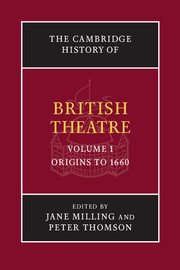Book contents
- Frontmatter
- PART I PRE-ELIZABETHAN THEATRE
- 1 From Roman to Renaissance in drama and theatre
- 2 Faith, pastime, performance and drama in Scotland to 1603
- 3 The Bible as play in Reformation England
- 4 Drama in 1553: continuity and change
- PART II ELIZABETHAN THEATRE
- PART III JACOBEAN AND CAROLINE THEATRE
- Works Cited
- Index
- References
4 - Drama in 1553: continuity and change
from PART I - PRE-ELIZABETHAN THEATRE
Published online by Cambridge University Press: 28 March 2008
- Frontmatter
- PART I PRE-ELIZABETHAN THEATRE
- 1 From Roman to Renaissance in drama and theatre
- 2 Faith, pastime, performance and drama in Scotland to 1603
- 3 The Bible as play in Reformation England
- 4 Drama in 1553: continuity and change
- PART II ELIZABETHAN THEATRE
- PART III JACOBEAN AND CAROLINE THEATRE
- Works Cited
- Index
- References
Summary
This choice of a single year in British theatrical history is rather like a geological transect which makes an arbitrary cut through different strata. In doing so, it leaves some doubt about exactly how far the evidence which emerges is a true reflection since the theatrical process under examination, rather like a geological one, is subject to continuities and changes which cannot be wholly understood by reference to the sample alone. There is also the problem of near misses, since we find that although some theatrical events certainly did occur precisely in the calendar year 1553 (new style), what happened in adjacent years ought to be taken into account if it colours what we know about the year in question.
The attraction of this particular year is partly that it marks a period of great political turmoil as Queen Mary came to the throne. Daughter of Catherine of Aragon, she had remained a Catholic, and her assumption of power meant a reversing of the increasingly Protestant tendencies of the brief reign of her brother, Edward VI (1547–53). She was proclaimed on 19 July, her brother having died thirteen days earlier, and the intervening period being marked by the attempt of the Duke of Northumberland to preserve the Protestant monarchy, and his own ascendancy, by proclaiming as queen his daughter-in-law, Lady Jane Grey. Alongside these momentous political events there are several theatrical items which can be definitely attributed to this particular year making it unusually rich in such occasions.
- Type
- Chapter
- Information
- The Cambridge History of British Theatre , pp. 116 - 136Publisher: Cambridge University PressPrint publication year: 2004



